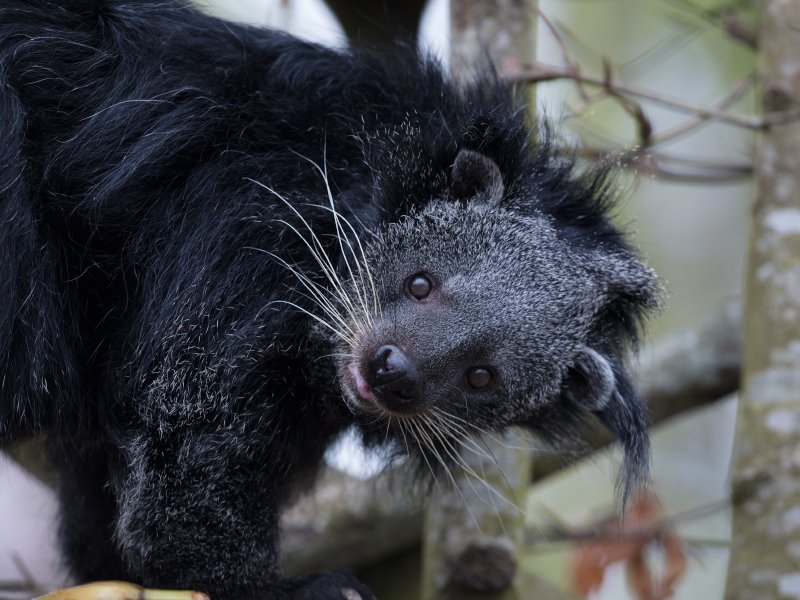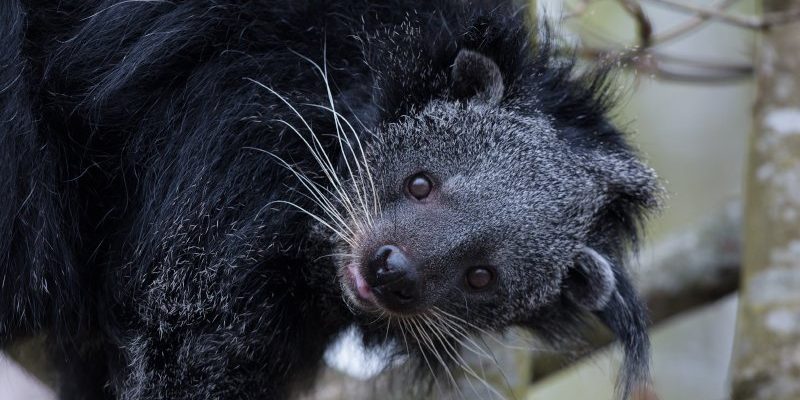
Have you ever heard of a creature that looks like a cross between a bear and a cat, and even smells like popcorn? That’s the binturong for you! This curious animal, also known as the bearcat, resides mainly in the tropical rainforests of Southeast Asia. With its distinct appearance and intriguing behaviors, the binturong certainly captures the imagination. Think of it as the quirky neighbor you’ve always wanted to meet but never quite get the chance.
The binturong’s most notable features include its shaggy black fur, bushy tail, and vivid expressions. While these animals may look cuddly, they’re far from domesticated companions. Instead, they’re part of a larger ecosystem, playing a vital role in their natural habitat. So, if you’re wondering what makes this creature so special, let’s dive into its world!
What is a Binturong?
The binturong (Arctictis binturong) is a medium-sized mammal that belongs to the family Viverridae, which also includes civets and genets. These fascinating animals have a unique blend of characteristics that set them apart from other wildlife. For one, their bodies are quite robust, with an average weight ranging from 50 to 100 pounds. What’s more, their long, prehensile tail can reach up to three feet, providing balance as they navigate their treetop homes.
You might be surprised to learn that binturongs are one of the few animals with a strong affinity for climbing, making them excellent arboreal creatures. Their sharp claws help them grasp branches, and their flexible bodies allow for graceful movement across the forest canopy. Interestingly, these animals are also nocturnal, meaning they come alive at night, much like the vibrant nightlife of the cities they inhabit.
Physical Characteristics
Binturongs have a striking appearance, with thick, shaggy fur that ranges from black to dark brown. Their fur not only provides insulation but also plays a role in camouflage among the trees. Their faces are marked by large, expressive eyes and rounded ears that give them an endearing look. One of the most fascinating features is their long tail, which is not only used for balance but also serves as a tool for communication and social interaction.
To give you a better idea of their size and attributes, here’s a quick look:
| Attribute | Details |
| Average Weight | 50 – 100 pounds |
| Length | About 24 – 36 inches (excluding tail) |
| Tail Length | Up to 3 feet |
| Habitat | Tropical rainforests, mountainous areas |
| Diet | Omnivorous (fruits, insects, small animals) |
| Life Span | Up to 25 years in captivity |
Habitat and Distribution
Binturongs are primarily found in the lush tropical rainforests of Southeast Asia, including countries like Thailand, Malaysia, and Indonesia. Their preferred habitats are areas with dense vegetation, as this provides ample food sources and shelter from predators. These animals are well-adapted to life in the trees, where they spend most of their time foraging for food and resting.
However, their habitat is increasingly threatened due to deforestation and human encroachment. As trees are cut down for agriculture or urban development, the binturong’s home shrinks. This loss of habitat not only puts their survival at risk but also affects the entire ecosystem, as binturongs play a crucial role in seed dispersal. They consume a variety of fruits, and their movements help spread the seeds throughout the forest.
Diet and Feeding Habits
Binturongs have a diverse diet, which makes them omnivores. They enjoy munching on fruits, particularly figs, which form a significant part of their diet. Fruits are their go-to source of nutrition, but they’re not picky eaters. These critters will also eat small animals, insects, and even carrion if the opportunity arises. Their sense of smell is quite acute, allowing them to locate food sources from a distance.
What’s really fascinating is their unique way of eating. When feeding on fruit, they often use their paws to grasp and manipulate the food, showing off their dexterity. You might compare their foraging style to that of a toddler exploring new foods. They tend to take their time, investigating each piece before deciding on it. This feeding behavior not only helps them satisfy their hunger but also aids in maintaining the health of their ecosystem by contributing to seed dispersal.
Behavior and Social Structure
When it comes to social structure, binturongs are generally solitary creatures. However, they do come together during mating season and occasionally share their territory with others. Their communication relies heavily on vocalizations and scent markings. You’ll often hear a variety of sounds, from low growls to high-pitched whistles, which they use to signal their presence to others or express their emotions.
While they’re not known for their acrobatic skills, binturongs are surprisingly agile when navigating the treetops. Their climbing ability is supported by strong limbs and sharp claws, making them proficient at scaling trees. In an interesting twist, they also engage in playful behavior, especially when young, such as swinging from branches and chasing each other. This playfulness is essential for developing their skills and social bonds.
Conservation Status
Currently, binturongs are classified as vulnerable by the International Union for Conservation of Nature (IUCN). Their population is declining primarily due to habitat loss and illegal hunting. As the forests shrink, the challenges for binturongs increase. Conservation efforts are crucial for ensuring their survival in the wild. Protecting their habitats and implementing anti-poaching measures are essential steps toward this goal.
Moreover, raising awareness about binturongs and their ecological importance can help foster a connection between humans and wildlife. Many organizations are working toward educating local communities about sustainable practices that can coexist with wildlife, ensuring that future generations can appreciate these fascinating creatures.
FAQ
What is a binturong’s lifespan in the wild?
In the wild, binturongs typically live around 15 to 20 years. Their lifespan can be affected by various factors, including food availability, habitat conditions, and threats from predators. In captivity, they have been known to live up to 25 years, where they receive consistent care and protection.
Are binturongs good pets?
Binturongs are not suitable pets. While they may look adorable, they have complex needs and require specialized care that most pet owners can’t provide. Additionally, their wild nature makes them unpredictable, which can pose challenges in a domestic setting. Instead, it’s best to appreciate them in their natural habitat or through reputable wildlife sanctuaries.
Do binturongs have any natural predators?
While binturongs are relatively safe in their arboreal habitats, they can fall prey to large carnivorous animals such as big cats or birds of prey. Young binturongs are particularly vulnerable due to their size. Their climbing abilities help them evade threats, but they must always remain cautious in their environment.
How do binturongs contribute to their ecosystem?
Binturongs play an essential role in their ecosystem as seed dispersers. By eating fruits and moving throughout the forest, they help spread seeds, contributing to the regeneration of the forest. This process is vital for maintaining biodiversity and the overall health of their habitat.
Can you hear binturongs from a distance?
Yes, binturongs are known for their wide range of vocalizations. They can make sounds from growls and hisses to high-pitched calls that can travel through the forest. Their vocalizations play a crucial role in communication and can alert others to their presence.
What do binturongs smell like?
Interestingly, binturongs smell like popcorn! This unique scent arises from the natural oils in their fur. This popcorn-like aroma can vary depending on their diet, but it’s a delightful and unexpected trait that many people find fascinating.
Are binturongs active during the day or night?
Binturongs are primarily nocturnal, meaning they are most active during the night. They prefer foraging for food and exploring their territory under the cover of darkness. This nocturnal behavior helps them avoid daytime predators and reduces competition for food.
Do binturongs mate for life?
Binturongs do not mate for life. They come together during the breeding season, and after mating, the female usually raises the young on her own. The bond between mating pairs is typically temporary, and they may go their separate ways after the breeding period.
What challenges do binturongs face in the wild?
Binturongs face several challenges in the wild, primarily habitat destruction due to deforestation and the illegal wildlife trade. As their habitats are lost, their food sources decline, making survival more difficult. Conservation efforts are critical to address these issues and protect the future of this unique species.
How can we help protect binturongs?
You can help protect binturongs by supporting conservation organizations that work toward habitat preservation and wildlife protection. Educating others about the importance of binturongs and their role in the ecosystem can also contribute to awareness and action. Additionally, making sustainable choices in your daily life can help reduce the demand for products that harm their habitats.

